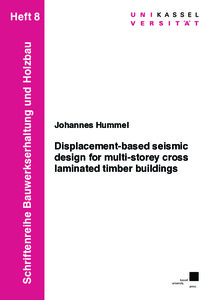| dc.date.accessioned | 2023-05-04T14:25:05Z | |
| dc.date.available | 2023-05-04T14:25:05Z | |
| dc.date.issued | 2017 | |
| dc.identifier | doi:10.19211/KUP9783737602891 | |
| dc.identifier.isbn | 978-3-7376-0289-1 (e-book) | |
| dc.identifier.uri | urn:nbn:de:0002-402896 | |
| dc.identifier.uri | http://hdl.handle.net/123456789/14653 | |
| dc.description | Zugleich: Dissertation, Universität Kassel, 2016 | ger |
| dc.language.iso | eng | eng |
| dc.publisher | kassel university press | |
| dc.rights | Urheberrechtlich geschützt | |
| dc.rights.uri | https://rightsstatements.org/page/InC/1.0/ | |
| dc.subject.ddc | 690 | |
| dc.title | Displacement-based seismic design for multi-storey cross laminated timber buildings | eng |
| dc.type | Buch | |
| dcterms.abstract | Timber and timber-based products have become increasingly attractive as construction material for multi-storey buildings in recent years. The reason for the booming interest in timber structures is mainly the need for sustainable buildings and their outstanding performance in terms of building physics and load-bearing behaviour including earthquake impact. Timber constructions offer high standards regarding demands on building physics and energy consumption. It is possible to erect buildings much faster in comparison to other structural materials due to a high level of prefabrication and a comparatively lightweight construction. There are a large number of companies with great expertise in the prefabrication of structural timber elements. This advances the quality of timber buildings considerably. Alternatively, PBD can be used for the seismic design of multi-storey timber structures. The advantage of PBD is that buildings can be designed based on predefined characteristics and independent of behaviour factors q. Different displacement-based design (DBD) procedures as part of PBD have been developed in the last five decades [Free98; Fajf99; Prie00] and adapted for timber structures, see e.g. [Fili02; Pang07; Merg15]. However, a systematic study on the limitations and the application of DBD with reference to multi-storey CLT buildings has not yet been conducted. This is where the present work becomes relevant. The purpose of this thesis is the application and the validation of DBD for multi-storey CLT buildings. This objective will be achieved on the basis of an analytical study of reference structures and a systematic comparison of design methods. The analytical study will obtain a basic understanding of the performance of the CLT construction under seismic action for different structural configurations. The comparison of different analysis methods will reveal the capabilities and limitations of DBD as a design method for multi-storey CLT buildings. It appears to be reasonable to focus on the CLT construction because of the potential of this material for engineered structures on the one hand and because of the ongoing discussion about basic definitions of structural characteristics on the other hand. The debate is mainly about an appropriate behaviour factor q. Several studies on the seismic behaviour of CLT structures were performed (see chapter 3) which aimed at the determination of a behaviour factor for the CLT construction. However, the research community does not yet completely agree upon the definition of behaviour factor q for CLT. This implies that the seismic performance of CLT structures is not yet fully understood. This thesis intends to provide improved DBD procedures for low- and mid-rise CLT buildings which might be an alternative to the behaviour-factor-based seismic design. These procedures should be suitable for different configurations of CLT structures. This thesis should also have an exemplary nature for engineers in practice regarding the development of appropriate structural models for non-linear analyses and DBD of multistorey CLT buildings. Input parameters and relationships, which are required for the application of DBD to CLT structures, will be provided. A further aim is the evaluation of existing DBD procedures in terms of their suitability for use with multi-storey CLT buildings. | eng |
| dcterms.accessRights | open access | |
| dcterms.creator | Hummel, Johannes | |
| dcterms.dateAccepted | 2016-09-23 | |
| dcterms.extent | xvi, 205 Seiten | |
| dc.contributor.corporatename | Kassel, Universität Kassel, Fachbereich Bauingenieur- und Umweltingenieurwesen | ger |
| dc.contributor.referee | Seim, Werner (Prof. Dr.) | |
| dc.contributor.referee | Fehling, Ekkehard (Prof. Dr.) | |
| dc.contributor.referee | Fragiacomo, Massimo (Prof. Dr.) | |
| dc.publisher.place | Kassel | |
| dc.relation.isbn | 978-3-7376-0288-4 (print) | |
| dc.subject.swd | Holzbau | ger |
| dc.subject.swd | Geschossbau | ger |
| dc.subject.swd | Brettsperrholz | ger |
| dc.subject.swd | Erdbebensicherheit | ger |
| dc.subject.swd | Holzkonstruktion | ger |
| dc.subject.swd | Erdbebenbelastung | ger |
| dc.subject.swd | Bemessung | ger |
| dc.type.version | publishedVersion | |
| dcterms.source.series | Schriftenreihe Bauwerkserhaltung und Holzbau | ger |
| dcterms.source.volume | Heft 8 | |
| kup.iskup | true | |
| kup.series | Schriftenreihe Bauwerkserhaltung und Holzbau | ger |
| kup.subject | Naturwissenschaft, Technik, Informatik, Medizin | |
| kup.typ | Dissertation | |
| kup.institution | FB 14 / Bauingenieur- und Umweltingenieurwesen | |
| ubks.nodoigen | true | |
| kup.binding | Softcover | |
| kup.size | DIN A4 | |


